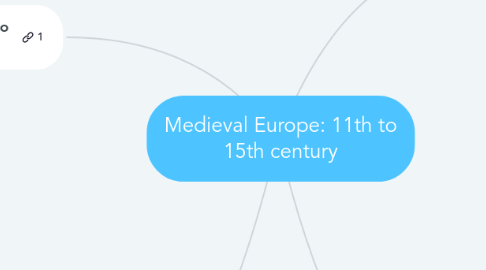
1. The Iberian Peninsula (11th to 13th century)
1.1. Political Situation 1031 to 1085
1.1.1. Al-Andalus
1.1.1.1. Taifas engage in 1031 were those of Sevilla, Badajoz and Zaragoza.
1.1.1.1.1. The Christian Kingdoms were
1.2. Political Situation 1085 to 1212
1.2.1. Al-Andalus
1.2.1.1. Taifa kings were forced to seek help from Almoravids.
1.2.1.1.1. Aragón
1.2.1.1.2. León and Castilla
1.2.1.1.3. Portugal
1.2.2. Political Situation from 1212 to 1250
1.2.2.1. Battle of Navas de Tolosa was a major victory for Christian Kingdoms and occupate Guadalquivir was possible.
1.2.2.2. The Expansion through Repopulation
1.2.2.2.1. Presura
1.2.2.2.2. Concejos
1.2.2.2.3. Repartimiento
1.2.2.2.4. Capitulaciones
1.2.2.3. Fronter Society
1.2.2.3.1. Livestock farmers
1.2.2.3.2. Military Orders
1.2.2.4. Economy
1.2.2.4.1. Castilla and León
1.2.2.4.2. Crown of Aragón
1.2.2.4.3. All economy was based in Castilla and León and Aragón.
2. The Iberian Peninsula (13th and 15th century)
2.1. Castilla
2.1.1. Civil wars between Pedro I of Castilla and Enrique of Trastámara. Enrique II was victorious and acceded to throne of the Trastámara dinasty
2.2. Aragón
2.2.1. King Martin I died without an heir in 1310. in 1312 representatives constitutions choosed a new king.
3. The High Middle Ages
3.1. Resurgence of Cities
3.1.1. 11th century on agricultural productivity increased.
3.1.1.1. Increase Rural Population
3.1.1.2. Agricultural Surpluses
3.2. Urban Society
3.2.1. Population
3.2.1.1. Great Merchants
3.2.1.2. Trader,Craftsmen
3.2.1.3. Workers and Peasants
3.3. Guilds
3.3.1. Associations of Craftsmen with the same trade and they were hierarchical of: masters, officials, apprentices. And live in the same street and they are neighbourhoods with the name of the work.
3.4. Trade
3.4.1. It was a revitalisation of trade in the High Middle Ages
3.4.1.1. Safer Trade Routes
3.4.1.2. Technical Advances in transport
3.4.1.3. Increase in coins in circulation: dicat (Venice) florin (Florence)
3.4.1.4. Appearance of Bankers and Lenders
3.4.2. And they organised fairs. These was trade meetings under protection of kings and nobles to ensure their safety.
3.5. Political Institutions
3.5.1. Two Institutions
3.5.1.1. Papacy
3.5.1.1.1. The Pope in Rome was a high moral authority of Catholicism and also aspired to hold political superiority.
3.5.1.2. Empire
3.5.1.3. Monarchy was important too in High Middle Ages
4. The Late Middle Ages
4.1. Crisis 14th century
4.1.1. Religious Crisis
4.1.2. Political Crisis
4.1.3. Demographic Crisis
4.2. Social Crisis
4.2.1. In Countryside
4.2.2. In Cities
4.2.3. Mass Revolts
4.3. The end of the Middle Ages
4.3.1. 15th century represented period of recovery, especially in trade. Bankers led money and contributed to strengthening their power.

